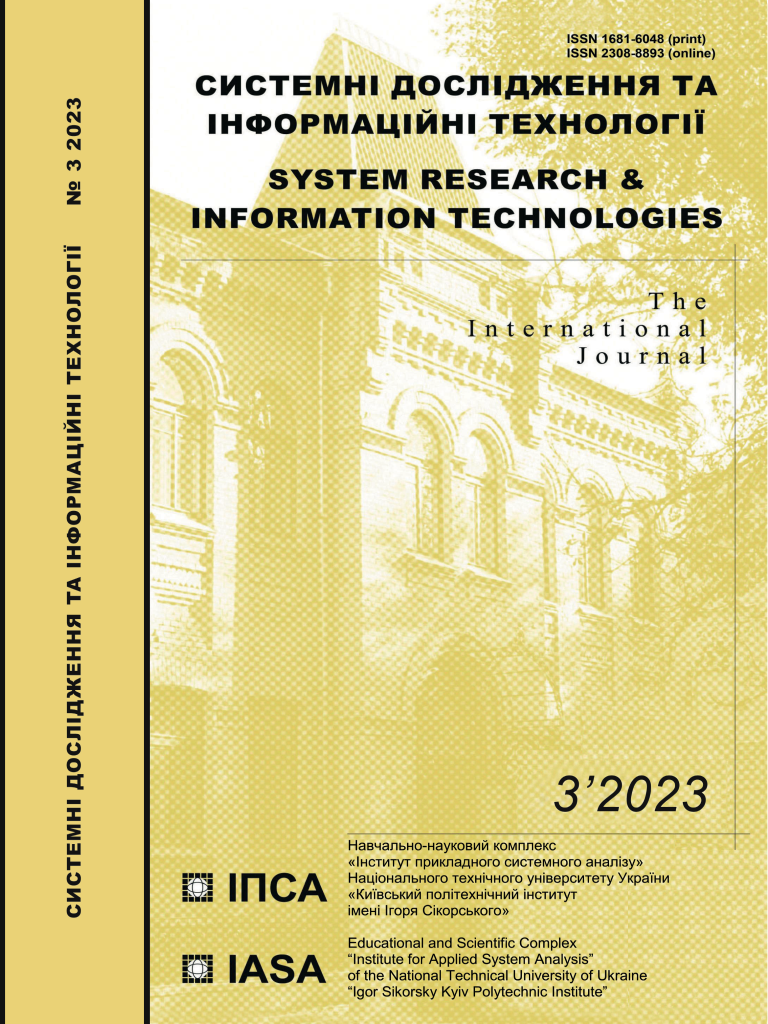A concatenation approach-based disease prediction model for sustainable health care system
DOI:
https://doi.org/10.20535/SRIT.2308-8893.2023.3.06Keywords:
feature extraction, disease prediction, deep learning, Inception V3, XceptionAbstract
In the present world, due to many factors like environmental changes, food styles, and living habits, human health is constantly affected by different diseases, which causes a huge amount of data to be managed in health care. Some diseases become life-threatening if they are not cured at the starting stage. Thus, it is a complex task for the healthcare system to design a well-trained disease prediction model for accurately identifying diseases. Deep learning models are the most widely used in disease prediction research, but their performance is inferior to conventional models. In order to overcome this issue, this work introduces the concatenation of Inception V3 and Xception deep learning convolutional neural network models. The proposed model extracts the main features and produces the prediction result more accurately than traditional predictive models. This work analyses the performance of the proposed model in terms of accuracy, precision, recall, and f1-score. It compares the proposed model to existing techniques such as Stacked Denoising Auto-Encoder (SDAE), Logistic Regression (LR), MLP, MLP with attention mechanism (MLP-A), Support Vector Machine (SVM), Multi Neural Network (MNN), and Hybrid Convolutional Neural Network (CNN)-Random Forest (RF).
References
Adekunle O. Afolabi and Pekka Toivanen, “Integration of Recommendation Systems into Connected Health for Effective Management of Chronic Diseases,” IEEE Access, vol. 7, pp. 49201– 49211, 2019.
Haolin Wang , Zhilin Huang, Danfeng Zhang, Johan Arief, Tiewei Lyu, and Jie Tian,“Integrating Co-Clustering and Interpretable Machine Learning for the Prediction of Intravenous Immunoglobulin Resistance in Kawasaki Disease,” IEEE Access, vol. 8, pp. 97064–97071, 2020.
Jian Ping Li, Amin Ul Haq, Salah Ud Din, Jalaluddin Khan, Asif Khan, and Abdus Saboor, “Heart Disease Identification Method Using Machine Learning Classification in E-Healthcare,” IEEE Access, vol. 6, pp. 107562–107582, 2020.
Neelum Noreen, Sellappan Palaniappan, Abdul Qayyum, Iftikhar Ahmad, Muhammad Imran, and Muhammad Shoaib, “A Deep Learning Model Based on Concatenation Approach for the Diagnosis of Brain Tumor,” IEEE Access, vol. 8, pp. 55135–55144, 2020.
Rajkumar Gangappa Nadakinamani et al., “Clinical Data Analysis for Prediction of Cardiovascular Disease Using Machine Learning Techniques,” Computational Intelligence and Neuroscience, pp.1–13, 2022.
Qian Wang, Hong Wang, Lutong Wang, and Fengping Yu, “Diagnosis of Chronic Obstructive Pulmonary Disease Based on Transfer Learning,” IEEE Access, vol. 8, pp. 47370–47383, 2020.
Lodewijk Brand, Kai Nichols, Hua Wang, Li Shen, and Heng Huang, “Joint Multi-Modal Longitudinal Regression and Classification for Alzheimer’s Disease Prediction,” IEEE Transactions on Medical Imaging, vol. 14, pp. 1–10, 2019.
Gazi Mohammed Ifraz, Muhammad Hasnath Rashid, Tahia Tazin, Sami Bourouis, and Mohammad Monirujjaman Khan, “Comparative Analysis for Prediction of Kidney Disease Using Intelligent Machine Learning Methods,” Computational and Mathematical Methods in Medicine, pp.1–10, 2021.
Hong Qing Yu and Stephan Reiff-Marganiec, “Targeted Ensemble Machine Classification Approach for Supporting IoT Enabled Skin Disease Detection,” IEEE Access, vol. 8, pp. 50244–50252, 2021.
Mohamed A. Hedeya, Ahmad H. Eid, and Rehab F. Abdel-Kader, “A Super-Learner Ensemble of Deep Networks for Vehicle-Type Classification,” IEEE Access, vol. 8, pp. 98266–98280, 2020.
Cuiping Shi, Ruiyang Xia, and Liguo Wang, “A Novel Multi-Branch Channel Expansion Network for Garbage Image Classification,” IEEE Access, vol. 8, pp. 154437–154452, 2020.
Aqsa Rahim, Yawar Rasheed, Farooque Azam, Muhammad Waseem Anwar, Muhammad Abdul Rahim, and Abdul Wahab Muzaffar, “An Integrated Machine Learning Framework for Effective Prediction of Cardiovascular Diseases,” IEEE Access, vol. 9, pp. 106575–106588, 2021.
Bin Liu, Cheng Tan, Shuqin Li, Jinrong He, and Hongyan Wang, “A Data Augmentation Method Based on Generative Adversarial Networks for Grape Leaf Disease Identification,” IEEE Access, vol. 8, pp. 102188–102198, 2020.
Rohit Bharti, Aditya Khamparia, Mohammad Shabaz, Gaurav Dhiman, Sagar Pande, and Parneet Singh, “Prediction of Heart Disease Using a Combination of Machine Learning and Deep Learning,” Computational Intelligence and Neuroscience, pp. 1–11, 2021.
Muhammad Imran Razzak, Muhammad Imran, and Guandong Xu, “Efficient Brain Tumor Segmentation with Multiscale Two-Pathway-Group Conventional Neural Networks,” IEEE Journal of Biomedical and Health Informatics, pp.1–10, 2018.
Hania H. Faraga, Lamiaa A.A. Saidb, Mohamed R.M. Rizka, and Magdy Abd ElAzim Ahmedc, “Hyperparameters optimization for ResNet and Xception in the purpose of diagnosingCOVID-19,” Journal of Intelligent & Fuzzy Systems, pp. 3555–3571, 2021.
Prabira Kumar Sethya, Santi Kumari Beherab, Komma Anithac, Chanki Pandeyd, and M.R. Khand, “Computer aid screening of COVID-19 usingX-ray and CT scan images:An inner comparison,” Journal of X-Ray Science and Technology, pp. 197–210.
Cheng Wang et al., “Pulmonary Image classification based on Inception-V3 Transfer Learning Model,” IEEE Access, vol. 7, pp. 146533–146541, 2019.
Qingmao Zeng, Xinhui Ma, Baoping Cheng, Erxun Zhou, and Wei Pang, “GANs-Based Data Augmentation for Citrus Disease Severity Detection Using Deep Learning,” IEEE Access, vol. 8, pp. 172882–172891, 2020.
Gaobo Liang, Huichao Hong, Weifang Xie, and Lixin Zheng, “Combining Convolutional Neural Network With Recursive Neural Network for Blood Cell Image Classification,” IEEE Access, vol. 6, pp. 36188–36197, 2018.
Chen Huang , Xiaochen Wang, Jiannong Cao, Shihui Wang, and Yan Zhang, “HCF: A Hybrid CNN Framework for Behavior Detection of Distracted Drivers,” IEEE Access, vol. 8, pp. 109335–109349, 2020.
Joel Parente De Oliveira, Marly Guimarães Fernandes Costa, and Cícero Costa Filho, “Methodology of Data Fusion Using Deep Learning for Semantic Segmentation of Land Types in the Amazon,” IEEE Access, vol. 8, pp. 187864–187875, 2020.
Andrés Anaya-Isaza, Leonel Mera-Jiménez, Johan Manuel Cabrera-Chavarro, Lorena Guachi-Guachi, Diego Peluffo-Ordóñez, and Jorge Ivan Rios-Patiño, “Comparison of Current Deep Convolutional Neural Networks for the Segmentation of Breast Masses in Mammograms,” IEEE Access, vol. 9, pp. 152206–152225, 2021.
Sin-Ae Lee, Hyun Chin Cho, and Hyun-Chong Cho, “A Novel Approach for Increased Convolutional Neural Network Performance in Gastric-Cancer Classification Using Endoscopic Images,” IEEE Access, vol. 9, pp. 51847–51854, 2021.
Yan Zhao, Baoqiang Ma, Pengbo Jiang, Debin Zeng, Xuetong Wang, and Shuyu Li, “Prediction of Alzheimer’s Disease Progression with Multi-Information Generative Adversarial Network,” IEEE Journal of Biomedical and Health Informatics,vol. 25, pp. 711–719, 2020.
Sudarshan Nandy, Mainak Adhikari, Venki Balasubramanian, Varun G. Menon, Xingwang Li, and Muhammad Zakarya, “An intelligent heart disease prediction system based on swarm artificial neural network,” Neural Computing and Applications, pp. 1–15, 2021.

